2017 NISSAN SENTRA fuel pressure
[x] Cancel search: fuel pressurePage 192 of 491
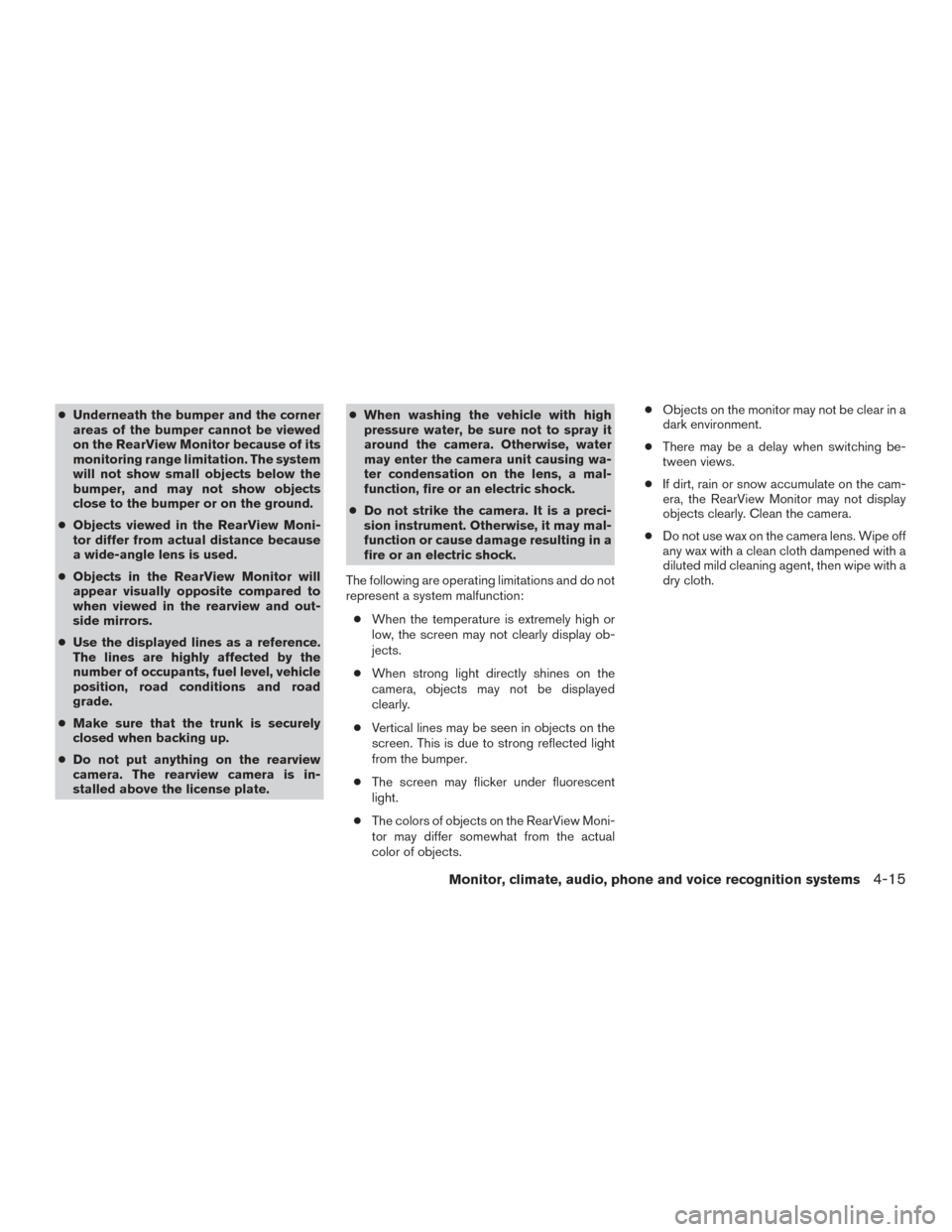
●Underneath the bumper and the corner
areas of the bumper cannot be viewed
on the RearView Monitor because of its
monitoring range limitation. The system
will not show small objects below the
bumper, and may not show objects
close to the bumper or on the ground.
● Objects viewed in the RearView Moni-
tor differ from actual distance because
a wide-angle lens is used.
● Objects in the RearView Monitor will
appear visually opposite compared to
when viewed in the rearview and out-
side mirrors.
● Use the displayed lines as a reference.
The lines are highly affected by the
number of occupants, fuel level, vehicle
position, road conditions and road
grade.
● Make sure that the trunk is securely
closed when backing up.
● Do not put anything on the rearview
camera. The rearview camera is in-
stalled above the license plate. ●
When washing the vehicle with high
pressure water, be sure not to spray it
around the camera. Otherwise, water
may enter the camera unit causing wa-
ter condensation on the lens, a mal-
function, fire or an electric shock.
● Do not strike the camera. It is a preci-
sion instrument. Otherwise, it may mal-
function or cause damage resulting in a
fire or an electric shock.
The following are operating limitations and do not
represent a system malfunction: ● When the temperature is extremely high or
low, the screen may not clearly display ob-
jects.
● When strong light directly shines on the
camera, objects may not be displayed
clearly.
● Vertical lines may be seen in objects on the
screen. This is due to strong reflected light
from the bumper.
● The screen may flicker under fluorescent
light.
● The colors of objects on the RearView Moni-
tor may differ somewhat from the actual
color of objects. ●
Objects on the monitor may not be clear in a
dark environment.
● There may be a delay when switching be-
tween views.
● If dirt, rain or snow accumulate on the cam-
era, the RearView Monitor may not display
objects clearly. Clean the camera.
● Do not use wax on the camera lens. Wipe off
any wax with a clean cloth dampened with a
diluted mild cleaning agent, then wipe with a
dry cloth.
Monitor, climate, audio, phone and voice recognition systems4-15
Page 302 of 491
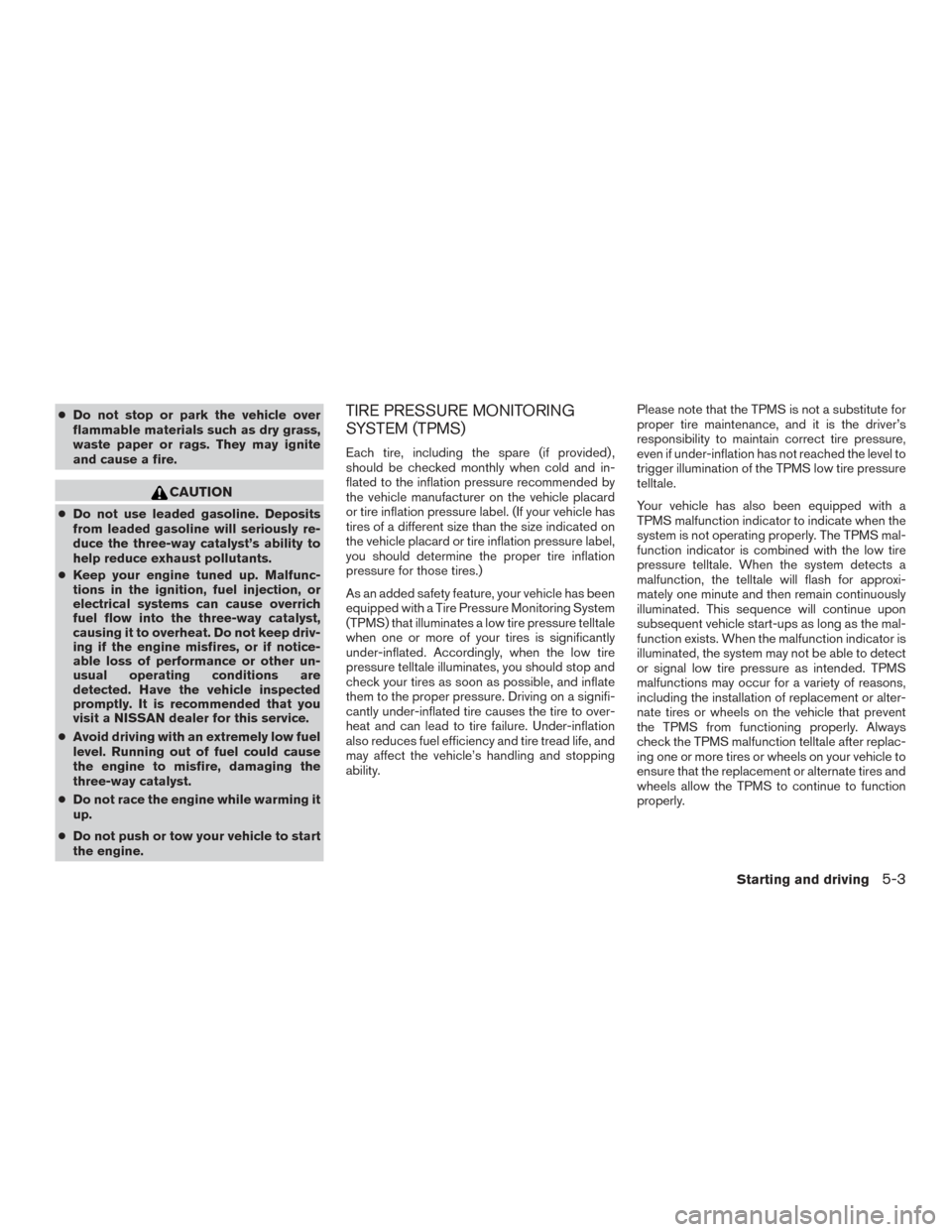
●Do not stop or park the vehicle over
flammable materials such as dry grass,
waste paper or rags. They may ignite
and cause a fire.
CAUTION
● Do not use leaded gasoline. Deposits
from leaded gasoline will seriously re-
duce the three-way catalyst’s ability to
help reduce exhaust pollutants.
● Keep your engine tuned up. Malfunc-
tions in the ignition, fuel injection, or
electrical systems can cause overrich
fuel flow into the three-way catalyst,
causing it to overheat. Do not keep driv-
ing if the engine misfires, or if notice-
able loss of performance or other un-
usual operating conditions are
detected. Have the vehicle inspected
promptly. It is recommended that you
visit a NISSAN dealer for this service.
● Avoid driving with an extremely low fuel
level. Running out of fuel could cause
the engine to misfire, damaging the
three-way catalyst.
● Do not race the engine while warming it
up.
● Do not push or tow your vehicle to start
the engine.
TIRE PRESSURE MONITORING
SYSTEM (TPMS)
Each tire, including the spare (if provided) ,
should be checked monthly when cold and in-
flated to the inflation pressure recommended by
the vehicle manufacturer on the vehicle placard
or tire inflation pressure label. (If your vehicle has
tires of a different size than the size indicated on
the vehicle placard or tire inflation pressure label,
you should determine the proper tire inflation
pressure for those tires.)
As an added safety feature, your vehicle has been
equipped with a Tire Pressure Monitoring System
(TPMS) that illuminates a low tire pressure telltale
when one or more of your tires is significantly
under-inflated. Accordingly, when the low tire
pressure telltale illuminates, you should stop and
check your tires as soon as possible, and inflate
them to the proper pressure. Driving on a signifi-
cantly under-inflated tire causes the tire to over-
heat and can lead to tire failure. Under-inflation
also reduces fuel efficiency and tire tread life, and
may affect the vehicle’s handling and stopping
ability. Please note that the TPMS is not a substitute for
proper tire maintenance, and it is the driver’s
responsibility to maintain correct tire pressure,
even if under-inflation has not reached the level to
trigger illumination of the TPMS low tire pressure
telltale.
Your vehicle has also been equipped with a
TPMS malfunction indicator to indicate when the
system is not operating properly. The TPMS mal-
function indicator is combined with the low tire
pressure telltale. When the system detects a
malfunction, the telltale will flash for approxi-
mately one minute and then remain continuously
illuminated. This sequence will continue upon
subsequent vehicle start-ups as long as the mal-
function exists. When the malfunction indicator is
illuminated, the system may not be able to detect
or signal low tire pressure as intended. TPMS
malfunctions may occur for a variety of reasons,
including the installation of replacement or alter-
nate tires or wheels on the vehicle that prevent
the TPMS from functioning properly. Always
check the TPMS malfunction telltale after replac-
ing one or more tires or wheels on your vehicle to
ensure that the replacement or alternate tires and
wheels allow the TPMS to continue to function
properly.
Starting and driving5-3
Page 369 of 491
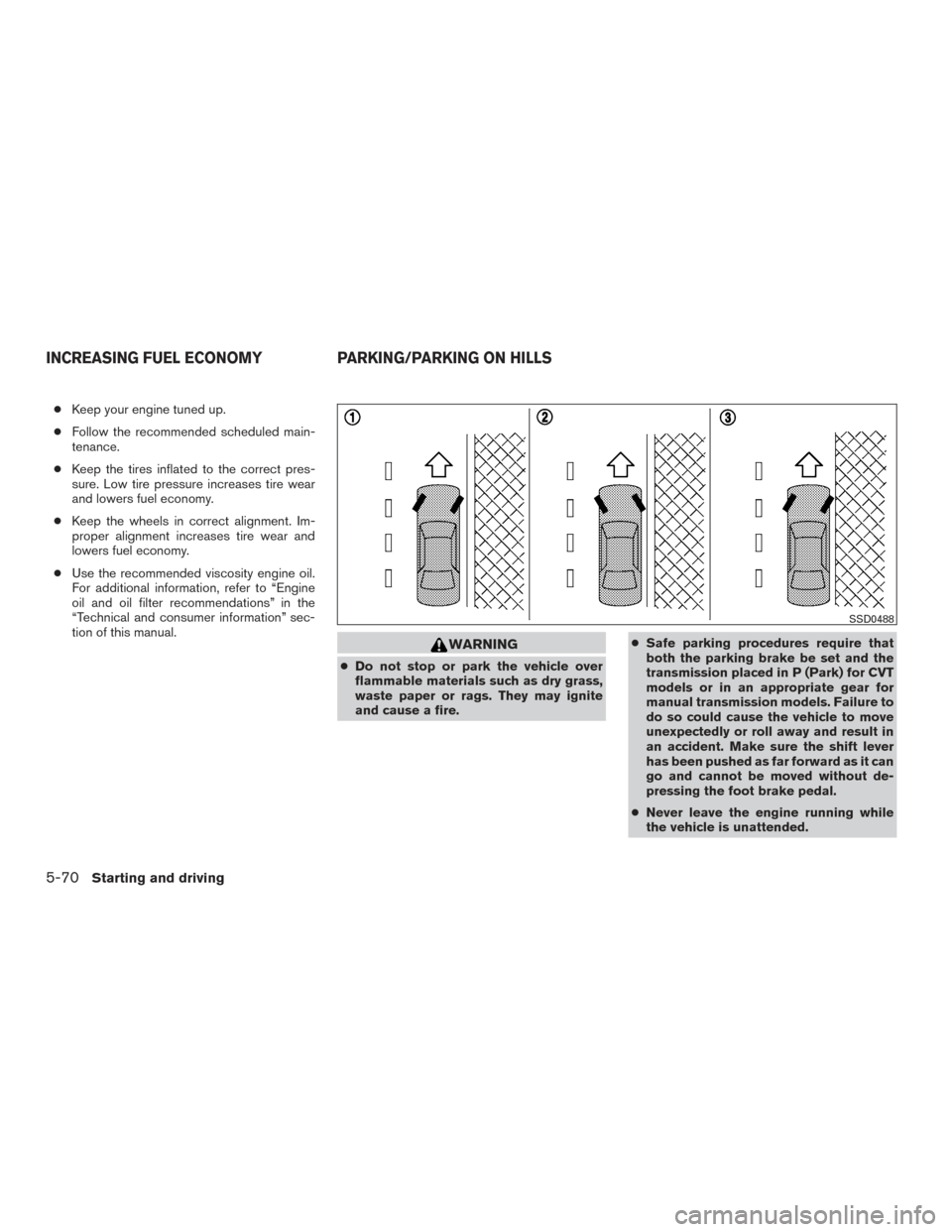
●Keep your engine tuned up.
● Follow the recommended scheduled main-
tenance.
● Keep the tires inflated to the correct pres-
sure. Low tire pressure increases tire wear
and lowers fuel economy.
● Keep the wheels in correct alignment. Im-
proper alignment increases tire wear and
lowers fuel economy.
● Use the recommended viscosity engine oil.
For additional information, refer to “Engine
oil and oil filter recommendations” in the
“Technical and consumer information” sec-
tion of this manual.
WARNING
● Do not stop or park the vehicle over
flammable materials such as dry grass,
waste paper or rags. They may ignite
and cause a fire. ●
Safe parking procedures require that
both the parking brake be set and the
transmission placed in P (Park) for CVT
models or in an appropriate gear for
manual transmission models. Failure to
do so could cause the vehicle to move
unexpectedly or roll away and result in
an accident. Make sure the shift lever
has been pushed as far forward as it can
go and cannot be moved without de-
pressing the foot brake pedal.
● Never leave the engine running while
the vehicle is unattended.
SSD0488
INCREASING FUEL ECONOMY PARKING/PARKING ON HILLS
5-70Starting and driving
Page 401 of 491
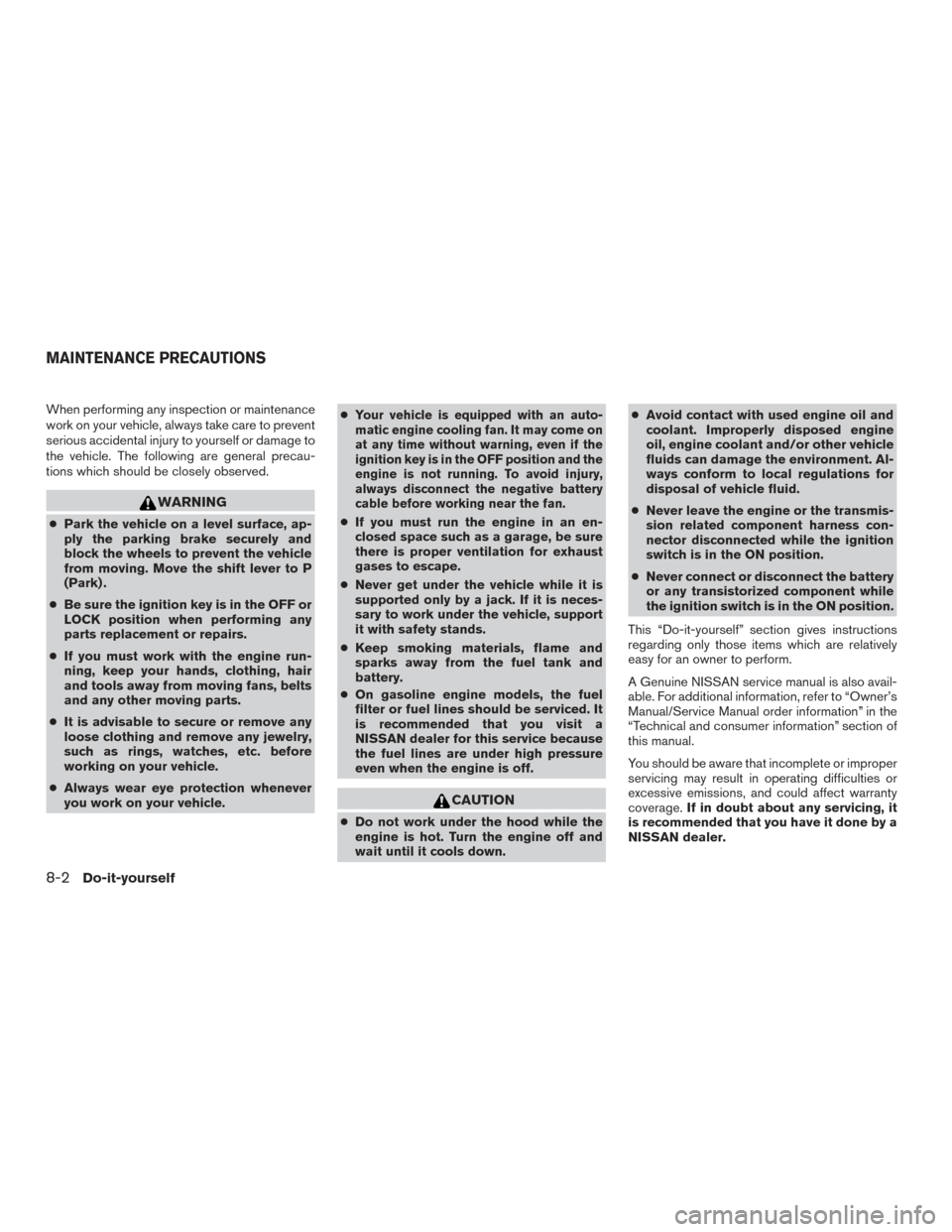
When performing any inspection or maintenance
work on your vehicle, always take care to prevent
serious accidental injury to yourself or damage to
the vehicle. The following are general precau-
tions which should be closely observed.
WARNING
●Park the vehicle on a level surface, ap-
ply the parking brake securely and
block the wheels to prevent the vehicle
from moving. Move the shift lever to P
(Park) .
● Be sure the ignition key is in the OFF or
LOCK position when performing any
parts replacement or repairs.
● If you must work with the engine run-
ning, keep your hands, clothing, hair
and tools away from moving fans, belts
and any other moving parts.
● It is advisable to secure or remove any
loose clothing and remove any jewelry,
such as rings, watches, etc. before
working on your vehicle.
● Always wear eye protection whenever
you work on your vehicle. ●
Your vehicle is equipped with an auto-
matic engine cooling fan. It may come on
at any time without warning, even if the
ignition key is in the OFF position and the
engine is not running. To avoid injury,
always disconnect the negative battery
cable before working near the fan.
● If you must run the engine in an en-
closed space such as a garage, be sure
there is proper ventilation for exhaust
gases to escape.
● Never get under the vehicle while it is
supported only by a jack. If it is neces-
sary to work under the vehicle, support
it with safety stands.
● Keep smoking materials, flame and
sparks away from the fuel tank and
battery.
● On gasoline engine models, the fuel
filter or fuel lines should be serviced. It
is recommended that you visit a
NISSAN dealer for this service because
the fuel lines are under high pressure
even when the engine is off.
CAUTION
● Do not work under the hood while the
engine is hot. Turn the engine off and
wait until it cools down. ●
Avoid contact with used engine oil and
coolant. Improperly disposed engine
oil, engine coolant and/or other vehicle
fluids can damage the environment. Al-
ways conform to local regulations for
disposal of vehicle fluid.
● Never leave the engine or the transmis-
sion related component harness con-
nector disconnected while the ignition
switch is in the ON position.
● Never connect or disconnect the battery
or any transistorized component while
the ignition switch is in the ON position.
This “Do-it-yourself” section gives instructions
regarding only those items which are relatively
easy for an owner to perform.
A Genuine NISSAN service manual is also avail-
able. For additional information, refer to “Owner’s
Manual/Service Manual order information” in the
“Technical and consumer information” section of
this manual.
You should be aware that incomplete or improper
servicing may result in operating difficulties or
excessive emissions, and could affect warranty
coverage. If in doubt about any servicing, it
is recommended that you have it done by a
NISSAN dealer.
MAINTENANCE PRECAUTIONS
8-2Do-it-yourself
Page 483 of 491
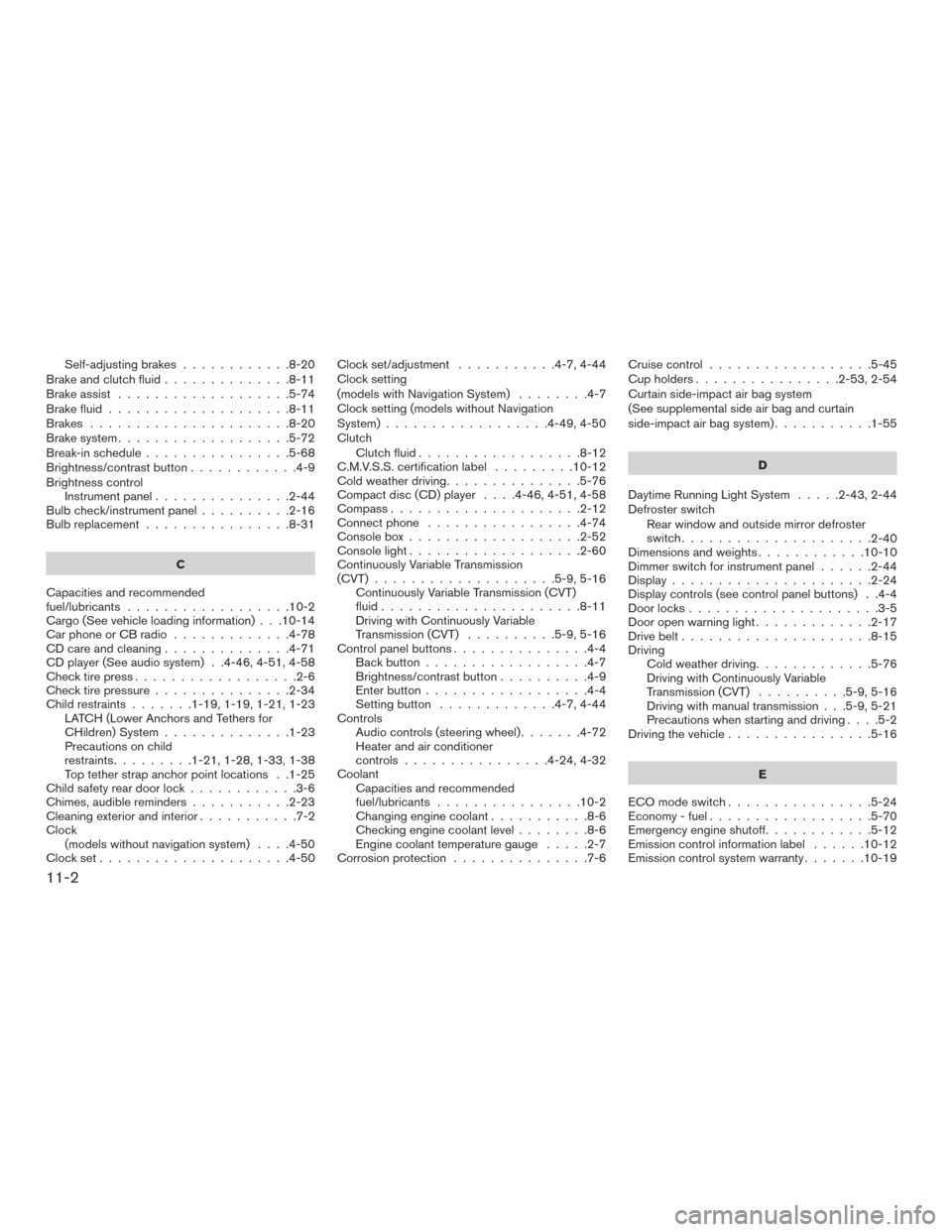
Self-adjusting brakes............8-20
Brake and clutch fluid ..............8-11
Brake assist ...................5-74
Brake fluid ....................8-11
Brakes ......................8-20
Brake system ...................5-72
Break-in schedule ................5-68
Brightness/contrastbutton............4-9
Brightness control Instrument panel ...............2-44
Bulb check/instrument panel ..........2-16
Bulb replacement ................8-31
C
Capacities and recommended
fuel/lubricants ..................10-2
Cargo (See vehicle loading information) . . .10-14
Car phone or CB radio .............4-78
CD care and cleaning ..............4-71
CD player (See audio system) . .4-46, 4-51, 4-58
Check tire press ..................2-6
Check tire pressure ...............2-34
Child restraints .......1-19,1-19,1-21,1-23
LATCH (Lower Anchors and Tethers for
CHildren) System ..............1-23
Precautions on child
restraints.........1-21,1-28,1-33,1-38
Top tether strap anchor point locations . .1-25
Child safety rear door lock ............3-6
Chimes, audible reminders ...........2-23
Cleaningexteriorandinterior...........7-2
Clock (models without navigation system) ....4-50
Clockset.....................4-50 Clock set/adjustment
...........4-7,4-44
Clock setting
(models with Navigation System) ........4-7
Clock setting (models without Navigation
System) ..................4-49,4-50
Clutch Clutch fluid ..................8-12
C.M.V.S.S. certification label .........10-12
Cold weather driving ...............5-76
Compact disc (CD) player ....4-46,4-51,4-58
Compass .....................2-12
Connect phone .................4-74
Console box ...................2-52
Console light ...................2-60
Continuously Variable Transmission
(CVT) ....................5-9,5-16
Continuously Variable Transmission (CVT)
fluid......................8-11
Driving with Continuously Variable
Transmission (CVT) ..........5-9,5-16
Control panel buttons ...............4-4
Back button ..................4-7
Brightness/contrast button ..........4-9
Enterbutton..................4-4
Setting button .............4-7,4-44
Controls Audio controls (steering wheel) .......4-72
Heater and air conditioner
controls................4-24,4-32
Coolant Capacities and recommended
fuel/lubricants ................10-2
Changingenginecoolant...........8-6
Checking engine coolant level ........8-6
Engine coolant temperature gauge .....2-7
Corrosion protection ...............7-6 Cruisecontrol..................5-45
Cupholders................2-53,2-54
Curtain side-impact air bag system
(See supplemental side air bag and curtain
side-impact air bag system)
...........1-55
D
Daytime Running Light System .....2-43,2-44
Defroster switch Rear window and outside mirror defroster
switch .....................
2-40
Dimensionsandweights............10-10
Dimmer switch for instrument panel ......2-44
Display......................2-24
Display controls (see control panel buttons) . .4-4
Door locks .....................3-5
Door open warning light .............2-17
Drive belt .....................8-15
Driving Cold weather driving .............5-76
Driving with Continuously Variable
Transmission (CVT) ..........5-9,5-16
Driving with manual transmission . . .5-9, 5-21
Precautions when starting and driving ....5-2
Driving the vehicle ................5-16
E
ECO mode switch ................5-24
Economy-fuel..................5-70
Emergency engine shutoff ............5-12
Emission control information label ......10-12
Emission control system warranty .......10-19
11-2
Page 484 of 491
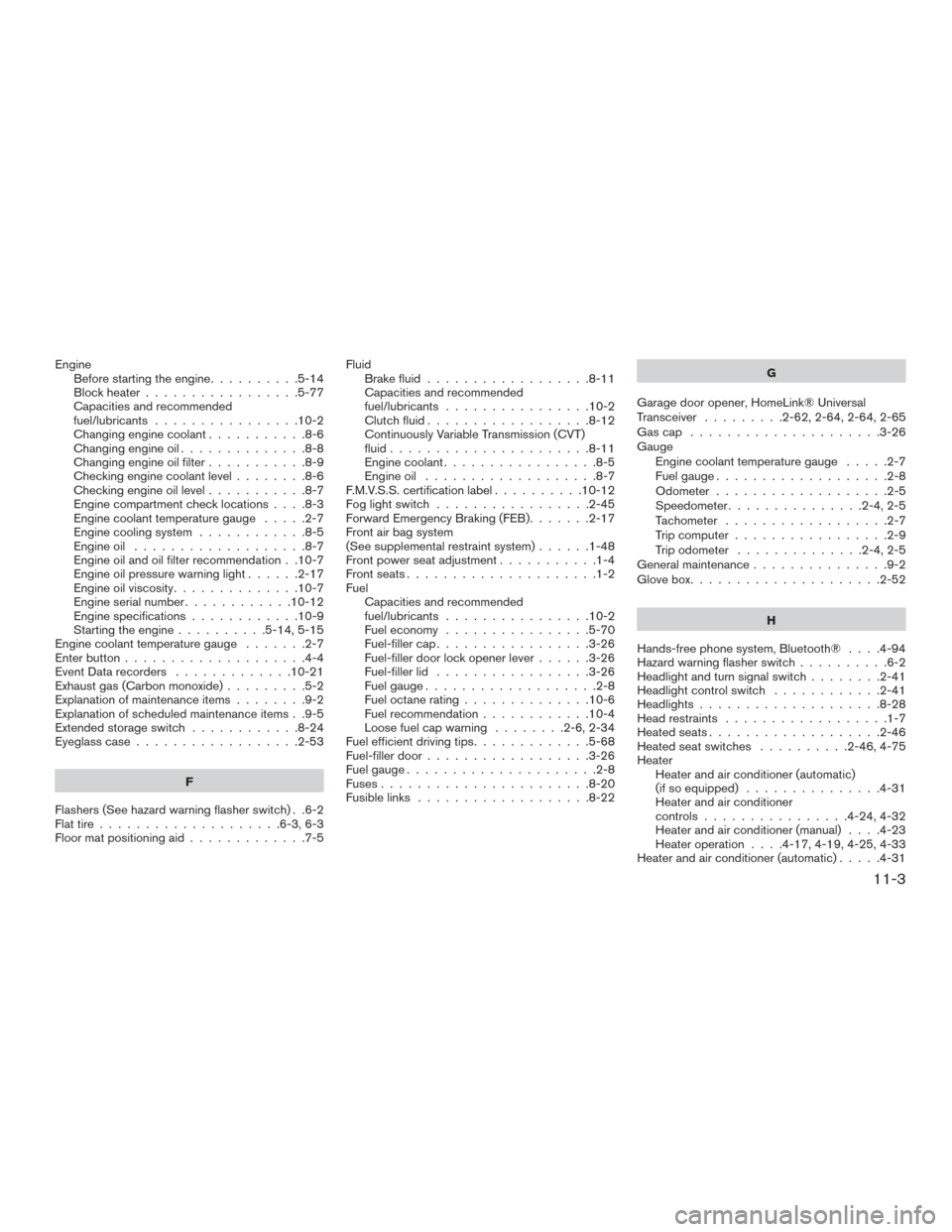
EngineBefore starting the engine ..........5-14
Block heater .................5-77
Capacities and recommended
fuel/lubricants ................10-2
Changing engine coolant ...........8-6
Changing engine oil ..............8-8
Changing engine oil filter ...........8-9
Checking engine coolant level ........8-6
Checking engine oil level ...........8-7
Engine compartment check locations ....8-3
Engine coolant temperature gauge .....2-7
Engine cooling system ............8-5
Engine oil ...................8-7
Engine oil and oil filter recommendation . .10-7
Engine oil pressure warning light ......2-17
Engine oil viscosity ..............10-7
Engine serial number ............10-12
Engine specifications ............10-9
Starting the engine ..........5-14,5-15
Engine coolant temperature gauge .......2-7
Enterbutton....................4-4
Event Data recorders .............10-21
Exhaust gas (Carbon monoxide) .........5-2
Explanation of maintenance items ........9-2
Explanation of scheduled maintenance items . .9-5
Extendedstorageswitch ............8-24
Eyeglass case ..................2-53
F
Flashers (See hazard warning flasher switch) . .6-2
Flat tire ....................6-3,6-3
Floor mat positioning aid .............7-5 Fluid
Brake fluid ..................8-11
Capacities and recommended
fuel/lubricants ................10-2
Clutch fluid ..................8-12
Continuously Variable Transmission (CVT)
fluid......................8-11
Engine coolant .................8-5
Engine oil ...................8-7
F.M.V.S.S. certification label ..........10-12
Foglightswitch .................2-45
Forward Emergency Braking (FEB) .......2-17
Front air bag system
(See supplemental restraint system) ......1-48
Front power seat adjustment ...........1-4
Frontseats.....................1-2
Fuel Capacities and recommended
fuel/lubricants ................10-2
Fuel economy ................5-70
Fuel-filler cap .................3-26
Fuel-filler door lock opener lever ......3-26
Fuel-filler lid .................3-26
Fuel gauge ...................2-8
Fuel octane rating ..............10-6
Fuel recommendation ............10-4
Loose fuel cap warning ........2-6,2-34
Fuel efficient driving tips .............5-68
Fuel-filler door ..................3-26
Fuelgauge.....................2-8
Fuses.......................8-20
Fusiblelinks ...................8-22 G
Garage door opener, HomeLink® Universal
Transceiver .........2-62,2-64,2-64,2-65
Gascap .....................3-26
Gauge Engine coolant temperature gauge .....2-7
Fuelgauge...................2-8
Odometer ...................
2-5
Speedometer ...............2-4,2-5
Tachometer ..................2-7
Trip computer .................2-9
Trip odometer ..............2-4,2-5
General maintenance ...............9-2
Glovebox.....................2-52
H
Hands-free phone system, Bluetooth® ....4-94
Hazard warning flasher switch ..........6-2
Headlightandturnsignalswitch........2-41
Headlightcontrolswitch ............2-41
Headlights....................8-28
Head restraints ..................1-7
Heated seats ...................2-46
Heated seat switches ..........2-46,4-75
Heater Heater and air conditioner (automatic)
(if so equipped) ...............4-31
Heater and air conditioner
controls ................4-24,4-32
Heater and air conditioner (manual) ....4-23
Heater operation ....4-17,4-19,4-25,4-33
Heater and air conditioner (automatic) .....4-31
11-3
Page 485 of 491
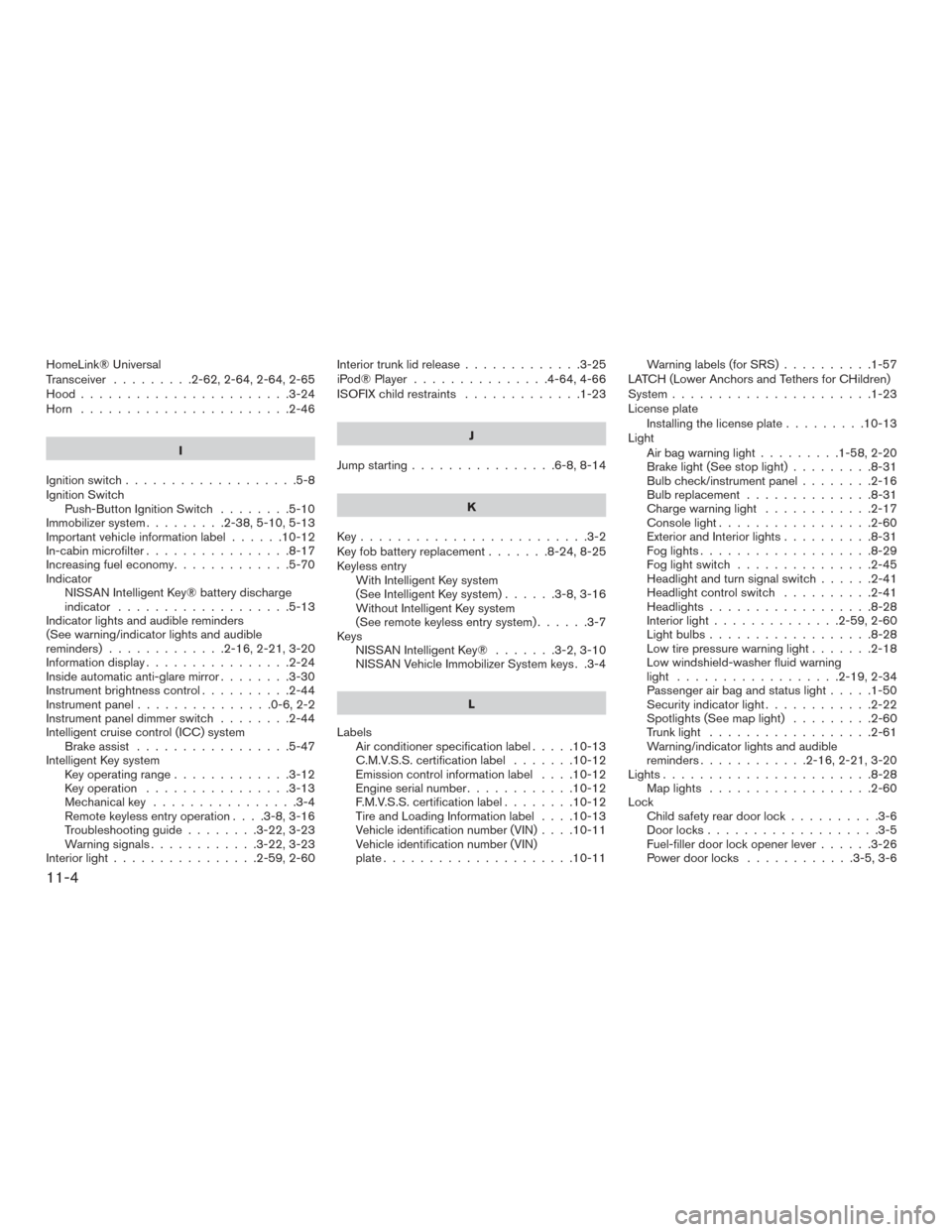
HomeLink® Universal
Transceiver .........2-62,2-64,2-64,2-65
Hood.......................3-24
Horn .......................2-46
I
Ignition switch ...................5-8
Ignition Switch Push-Button Ignition Switch ........5-10
Immobilizer system .........2-38,5-10,5-13
Important vehicle information label ......10-12
In-cabin microfilter ................8-17
Increasing fuel economy .............5-70
Indicator NISSAN Intelligent Key® battery discharge
indicator ...................5-13
Indicator lights and audible reminders
(See warning/indicator lights and audible
reminders).............2-16,2-21,3-20
Informationdisplay................2-24
Inside automatic anti-glare mirror ........3-30
Instrument brightness control ..........2-44
Instrument panel ...............0-6,2-2
Instrument panel dimmer switch ........2-44
Intelligent cruise control (ICC) system Brake assist .................5-47
Intelligent Key system Key operating range .............3-12
Key operation ................3-13
Mechanicalkey ................3-4
Remote keyless entry operation ....3-8,3-16
Troubleshooting guide ........3-22,3-23
Warning signals ............3-22,3-23
Interiorlight................2-59,2-60 Interiortrunklidrelease.............3-25
iPod® Player
...............4-64,4-66
ISOFIX child restraints .............1-23
J
Jump starting ................6-8,8-14
K
Key.........................3-2
Keyfobbatteryreplacement.......8-24,8-25
Keyless entry With Intelligent Key system
(See Intelligent Key system) ......3-8,3-16
Without Intelligent Key system
(See remote keyless entry system) ......3-7
Keys NISSAN Intelligent Key® .......3-2,3-10
NISSAN Vehicle Immobilizer System keys . .3-4
L
Labels Air conditioner specification label .....10-13
C.M.V.S.S. certification label .......10-12
Emission control information label ....10-12
Engine serial number ............10-12
F.M.V.S.S. certification label ........10-12
Tire and Loading Information label ....10-13
Vehicle identification number (VIN) ....10-11
Vehicle identification number (VIN)
plate.....................10-11 Warning labels (for SRS)
..........1-57
LATCH (Lower Anchors and Tethers for CHildren)
System ......................1-23
License plate Installing the license plate .........10-13
Light Air bag warning light .........1-58,2-20
Brake light (See stop light) .........8-31
Bulb check/instrument panel ........2-16
Bulbreplacement..............8-31
Charge warning light ............2-17
Console light .................2-60
Exterior and Interior lights ..........8-31
Foglights...................8-29
Fog light switch ...............2-45
Headlightandturnsignalswitch......2-41
Headlight
control switch ..........2-41
Headlights..................8-28
Interiorlight..............2-59,2-60
Lightbulbs..................8-28
Low tire pressure warning light .......2-18
Low windshield-washer fluid warning
light ..................2-19,2-34
Passenger air bag and status light .....1-50
Security indicator light ............2-22
Spotlights(Seemaplight) .........2-60
Trunklight ..................2-61
Warning/indicator lights and audible
reminders ............2 -16, 2-21, 3-20
Lights.......................8-28 Maplights ..................2-60
Lock Child safety rear door lock ..........3-6
Door locks ...................3-5
Fuel-filler door lock opener lever ......3-26
Power door locks ............3-5,3-6
11-4
Page 486 of 491
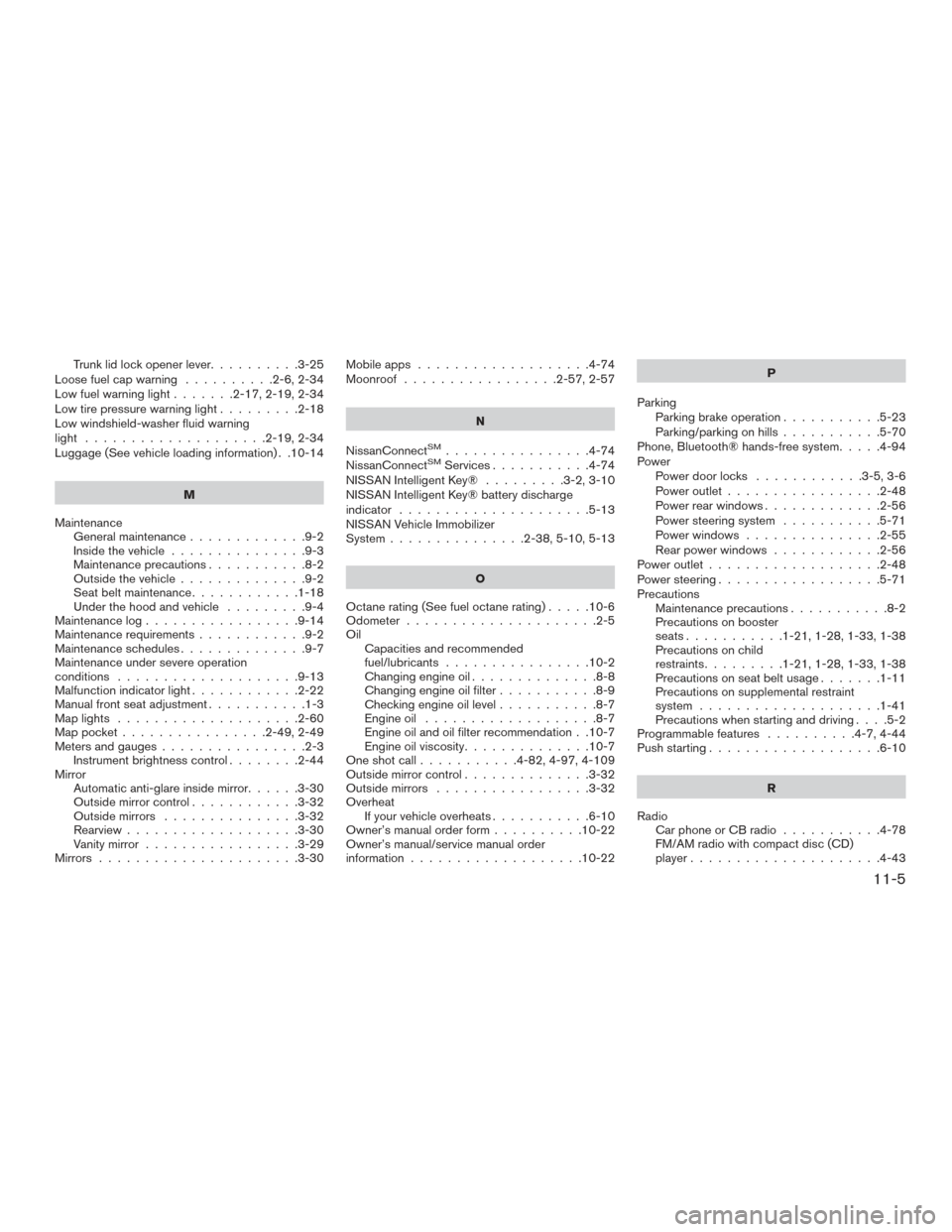
Trunk lid lock opener lever..........3-25
Loose fuel cap warning ..........2-6,2-34
Lowfuelwarninglight.......2-17,2-19,2-34
Low tire pressure warning light .........2-18
Low windshield-washer fluid warning
light ....................2-19,2-34
Luggage (See vehicle loading information) . .10-14
M
Maintenance General maintenance .............9-2
Insidethevehicle...............9-3
Maintenance precautions ...........8-2
Outside the vehicle ..............9-2
Seat belt maintenance ............1-18
Under the hood and vehicle .........9-4
Maintenance log .................9-14
Maintenance requirements ............9-2
Maintenance schedules ..............9-7
Maintenance under severe operation
conditions ....................9-13
Malfunction indicator light ............2-22
Manual front seat adjustment ...........1-3
Maplights ....................2-60
Map pocket ................2-49,2-49
Meters and gauges ................2-3
Instrument brightness control ........2-44
Mirror Automatic anti-glare inside mirror ......3-30
Outside mirror control ............3-32
Outside mirrors ...............3-32
Rearview ...................3-30
Vanity mirror .................3-29
Mirrors ......................3-30 Mobileapps ...................4-74
Moonroof
.................2-57,2-57
N
NissanConnect
SM................4-74
NissanConnectSMServices...........4-74
NISSAN Intelligent Key® .........3-2,3-10
NISSAN Intelligent Key® battery discharge
indicator .....................5-13
NISSAN Vehicle Immobilizer
System ...............2-38,5-10,5-13
O
Octane rating (See fuel octane rating) .....10-6
Odometer .....................2-5
Oil Capacities and recommended
fuel/lubricants ................10-2
Changingengineoil..............8-8
Changing engine oil filter ...........8-9
Checking engine oil level ...........8-7
Engine oil ...................8-7
Engine oil and oil filter recommendation . .10-7
Engine oil viscosity ..............10-7
Oneshotcall...........4-82,4-97,4-109
Outside mirror control ..............3-32
Outside mirrors .................3-32
Overheat If your vehicle overheats ...........6-10
Owner’s manual order form ..........10-22
Owner’s manual/service manual order
information ...................10-22 P
Parking Parking brake operation ...........5-23
Parking/parking on hills ...........5-70
Phone, Bluetooth® hands-free system .....4-94
Power Powerdoorlocks ............3-5,3-6
Power outlet .................2-48
Power rear windows .............2-56
Power steering system ...........5-71
Power windows ...............2-55
Rear power windows ............2-56
Power outlet ...................2-48
Power steering ..................5-71
Precautions Maintenance precautions ...........8-2
Precautions on booster
seats ...........1-21,1-28,1-33,1-38
Precautions on child
restraints .........1-21,1-28,1-33,1-38
Precautions on seat belt usage .......1-11
Precautions on supplemental restraint
system ....................1-41
Precautions when starting and driving ....5-2
Programmable features ..........4-7,4-44
Push starting ...................6-10
R
Radio CarphoneorCBradio ...........4-78
FM/AM radio with compact disc (CD)
player .....................4-43
11-5